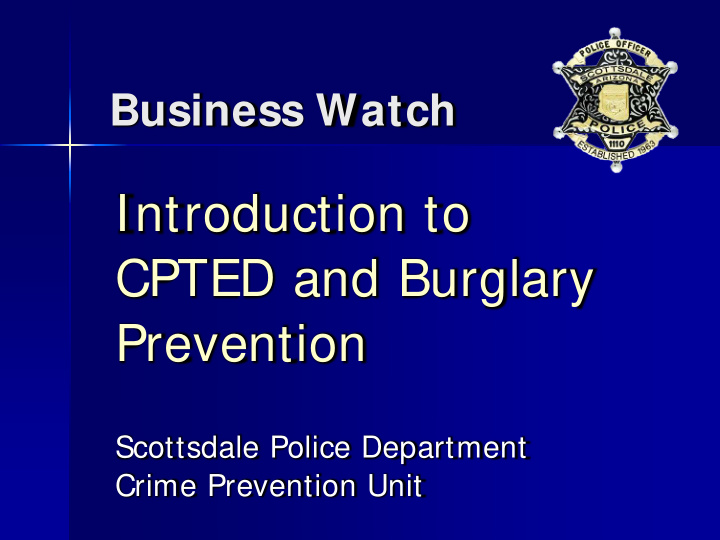



Business Watch Introduction to CPTED and Burglary Prevention Scottsdale Police Department Crime Prevention Unit
Objectives Reduce/Deter Commercial Burglary by : Understanding certain types of burglaries – Unforced – Forced – Window Smash/Door Kick Learning strategies to combat burglars – Target Hardening – CPTED – Security Systems – Business Watch Groups
Burglary Definition A.R.S. 13-1506A1 A person commits burglary in the third degree by: – Entering or remaining unlawfully in or on a nonresidential structure or in a fenced commercial or residential yard with the intent to commit any theft or felony within.
Commercial Burglaries
Commercial Burglaries
Forced Windows/ Doors Of the forced entries, glass breaks are normally the method of entry. This is not exactly unexpected. The windows are usually the weakest parts of a building.
Forced Windows/ Doors Window-smash burglary: – Takes seconds. Burglar never has to open the doors to your business. – More likely than forcing the doors open due to the time involved and increased difficulty.
Target Hardening Many burglars are opportunists and are looking for an easy mark. By making your business less attractive to criminals you can greatly reduce the chance of becoming a victim.
Target Hardening – Doors Wooden doors: – Make sure exterior wooden doors are solid wood. – Hollow core wooden doors provide no security at all.
Target Hardening – Doors Wooden doors Metal doors: – Made of steel sheets welded together and filled with an insulating material. – Used extensively in commercial properties. – Hollow metal doors provide adequate security.
Target Hardening – Doors Locks 1” bolt – If you have double doors, make sure the doors are pinned properly to avoid door slack. – The bolt through the strike should be a minimum of 1 inch in length when fully extended.
Target Hardening – Doors Wooden doors Metal doors Use deadbolts locks Spring action latches – can be easily manipulated, especially if you have a gap between frame and door.
Target Hardening – Doors Install Latch Guard to prevent ease of manipulating spring action latch.
Target Hardening – Doors Strike Plate: a metal plate mortised into the door jamb to receive the bolt or latch – 3” screws and a metal strike plate should be used with all strikes to reduce forcible entry. Don’t rely on the wooden door frame to catch the latch and dead- bolt. – Replace the small 1 inch screws with 3 inch screws.
Target Hardening - Windows Ideas to avoid window smash burglaries: – Window security film – Burglar resistant glass Plastics – acrylics, polycarbonate.
Target Hardening - Windows Move merchandise away from the windows or doors to prevent smash and grabs. Arrange window displays and lights so that a passerby and police can see into the store.
Target Hardening - Windows Do not cover up windows with marketing or display material.
CPTED CPTED is defined as “the proper design and effective use of the built environment that can lead to a reduction in the fear and incidence of crime and an improvement in the quality of life.”
CPTED In the psychology of a criminal, the complexity and length of time to complete a crime is crucial in determining whether he will accept the risk.
CPTED CPTED is based on these key overlapping concepts. 1. Natural access control 2. Natural surveillance 3. Territorial reinforcement 4. Maintenance
CPTED-Lighting Lighting of all exterior areas must be designed to maximize surveillance and minimize conflicts with building design and mature landscaping. – Light fixtures should not be blocked by mature tress. – High risk areas (ATM’s, parking lots, convenience stores) should be brighter than passive areas (parks, greenbelts, walkways). – Light exterior and interior of business. – The proper use of lighting will help reduce crime.
CPTED-Lighting
CPTED- Landscaping The design and placement of landscaping, regardless of intended or required function, should provide for natural surveillance and increased security of the area.
Security Systems Cameras – Make sure lighting is sufficient for the camera to capture nighttime activity. – Camera placement is vital. – DVR storage and compression matters. Burglary Alarms – Glass-break – Motion
Security Systems Security cameras may not always deter crime but can help with the investigation into the crime. Video information should be stored on a DVR system that can be “burned” to a DVD. Video analytics is a type of software for camera systems that helps identify abnormal behavior or motion. Motion activated security cameras.
Security Systems Make sure that the business fuse boxes are locked to prevent someone from cutting power to your business. – This could affect food inventory or other merchandise that is sensitive to temperature. – Burglar alarm systems could be defeated if the power source is cut. Does the vendor notify the owner if the power is cut. What is the length of time the battery back- up will work?
Broken Window Theory Don’t let your property get run down! – Keep buildings and walkways clean and repaired – Maintain parking areas to a high standard without pot-holes or trash. – Remove faded posters, broken signs, and other displays that are beyond their useful lives. – Maintain plants and landscaping
Don’t invite burglars…. Burglars may continue to return to the scene of a crime if you do not revoke the “invitation”!
Don’t invite burglars…. Cash Registers: – When closing your business, empty your cash drawers and leave them open.
Don’t invite burglars…. Safes: – Anchor safes to the floor.
Don’t invite burglars… Keep items that can be used as steps away from walls and fences.
Business Watch Groups Get with neighboring business to discuss neighborhood issues. Combine funds to add protection to business groups. Have meetings to share information – Suspicious people – Suspicious vehicles – Crime Trends
Questions? You can contact me: Officer Kory Sneed # 613 District Three Crime Prevention Officer 480-312-5696 ksneed@scottsdaleaz.gov
Recommend
More recommend